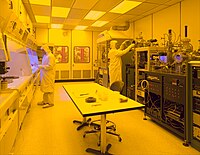
Photo from wikipedia
Abstract The self-alignment of microparts based on capillary forces and micrometer adhesive pads was evaluated through experimental evidence, analytical modelling and simulation. The local deposition of adhesive pads in the… Click to show full abstract
Abstract The self-alignment of microparts based on capillary forces and micrometer adhesive pads was evaluated through experimental evidence, analytical modelling and simulation. The local deposition of adhesive pads in the range of 2000 to 20 μm was realized by photo-lithographical patterning of an acrylate adhesive interlayer, followed by the spontaneous assembly with glass counterfaces that have a complementary array of hydrophobically modified gold structures. The design rules for self-alignment of microparts were studied from calculations of the capillary force and displacement as a function of the adhesive pad dimensions, pad heights and offset length. In all cases, the self-alignment induced by capillary forces is driven by a minimization of the surface energy, leading to an equilibrium position. The analytical results provided good qualitative understanding of the alignment process: larger dimensions, smaller separation and higher offset values contributed to higher forces and fast alignment. The simulation experiments in Surface Evolver were based on calculated geometries of adhesive pad providing a minimum surface energy and also take into account the local deformation of the adhesive pad together with an additional degree of rotational freedom. Consequently, the latter results indicated a high degree of precision with good correlation to the experiments and analytical results.
Journal Title: Journal of Manufacturing Processes
Year Published: 2020
Link to full text (if available)
Share on Social Media: Sign Up to like & get
recommendations!